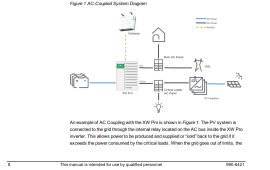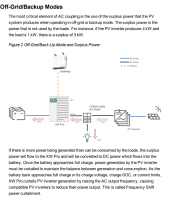Are you planning to turn off/open the grid connection other than those times when production is low? If not, and you don't want/can't backfeed the grid, then either you'll need to program something to speak Modbus and command the AC charging or the XW isn't the correct choice.
It's hot here too, those 100+ degree days all summer really suck down a lot of juice!
Yup, using more power when the sun is up makes AC coupled more efficient. It won't help on those days when the AC runs all night, but that's what the battery and DC panels are for.
That ratio is a hard number to nail down.
What does your AC consume?
What are your base loads?
Have you decided on a total PV or have a rough idea?
I've got a net metering agreement, but I can run the AC and most everything in the house on the XW when the grid goes down.
Correct
The XW (and Radian) has relays that will disconnect from the grid if the grid goes out of spec (high voltage, low voltage, high frequency, low frequency)
Yes that's correct. You'd then add a charge controller and PV connected to the battery.
I really like the next diagram down in that sheet, it gives an example of current flow when off grid.
View attachment 143074
Yup, the inverter turns into a charger and the home loads stay on, powered by PV.
You don't run the battery up to 100%
If you stop at 90 or 95% that should give you enough wiggle room to absorb the excess PV while the AC coupled inverter ramps down.
EG4 things their batteries do, I haven't seen success stories here, just complaints. But that's all anyone comes here for when EG4 or Signature Solar is involved.
You can also use battery voltage to regulate how the XW handles charging/discharging.
That's what I am doing, but my batteries are not Lifepo4, NMC has a much more linear voltage to SOC relationship.
You could set it to stop charging when AC coupled at 3.4 volts per cell.





